If you’re looking to take your networking career in 2024 to greater heights by attaining your Cisco Certified Network Associate (CCNA) certification, you may want to engage in an extensive and thorough CCNA Online Course that you can complete at your own pace.
You want to access CCNA training online that will help you build a solid foundation in networking concepts and learn and understand all the concepts that you need to pass the 200-301 CCNA exam.
In this post, I put together three CCNA video courses that you can access online today and provide you with a comprehensive curriculum of CCNA exam topics.
HOWTORouteSwitch.com is supported by readers. We may earn a commission when you buy with our links at no extra cost to you.
The following CCNA Online Training courses are available now at O’Reilly’s Online Learning Platform and will prepare you for the CCNA 200-301 examination.
CCNA 200-301 Complete Video Course
This CCNA 200-301 Complete Video Course is a comprehensive online training course that brings Cisco CCNA exam topics to life through the use of real-world demonstrations, animations, live instruction, and configurations, making learning these foundational networking topics easy and fun.
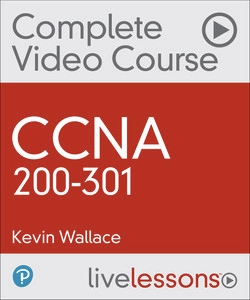
WATCH IT NOW on the O’Reilly Online Learning Platform with a 10-day free trial.
CCNA 200-301 Complete Video Course
Author: Kevin Wallace, CCIE No. 7945 (R/S & Collab)
Published: October 2019
Publisher: Pearson IT Certification
Length: More than 16 hours of instruction
- CCNA 200-301
- 0.0.0 Course Introduction
- 0.1.0 Performing Lab Exercises with Cisco Packet Tracer
- Module 1: Foundational Networking Technologies
- Lesson 1: Common Network Components
- 1.1.1 Routers
- 1.1.2 Switches
- 1.1.3 Security Appliances
- 1.1.4 Wireless Network Components
- 1.1.5 Endpoints and Servers
- 1.1.6 Cisco DNA Center
- 1.1.7 Virtualized Devices
- 1.1.8 TCP vs. UDP Protocols
- Lesson 2: Common Network Architectures and Designs
- 1.2.1 Collapsed Core vs. Three-Tier Architecture
- 1.2.2 Spine-Leaf Design for Data Centers
- 1.2.3 Wide Area Network (WAN) Topologies
- 1.2.4 Small Office – Home Office (SOHO) Architecture
- 1.2.5 On-Premise vs. Cloud Architectures
- Lesson 3: Network Cabling
- 1.3.1 Copper Media for Network Cables
- 1.3.2 Fiber Optic Media for Network Cables
- 1.3.4 Connectors for Network Cables
- 1.3.6 Shared Media vs. Point-to-Point Connections
- 1.3.7 Power over Ethernet (PoE)
- 1.3.8 Troubleshooting Common Cabling Issues
- Module 1 Summary
- Lesson 1: Common Network Components
- Module 2: IPv4 Addressing
- Lesson 1: IPv4 Address Structure
- 2.1.1 IPv4 Address Structure
- 2.1.2 IPv4 Address Classes
- 2.1.3 Public vs. Private IPv4 Addresses
- Lesson 2: IPv4 Address Assignment, Verification, and Name Resolution
- 2.2.1 Manual IPv4 Address Assignment
- 2.2.2 Dynamic IPv4 Address Assignment
- 2.2.3 Domain Name System (DNS)
- Lesson 3: Types of IPv4 Communication
- 2.3.1 IPv4 Unicast
- 2.3.2 IPv4 Broadcast
- 2.3.3 IPv4 Multicast
- Lesson 4: Binary Numbering
- 2.4.1 Binary Numbering Overview
- 2.4.2 Converting Binary Numbers to Decimal
- 2.4.3 Converting Decimal Numbers to Binary
- 2.4.4 IPv4 Exercise #1
- 2.4.5 IPv4 Exercise #2
- Lesson 5: Basic Subnetting
- 2.5.1 IPv4 Subnetting Overview
- 2.5.2 The Network Address
- 2.5.3 The Directed Broadcast Address
- 2.5.4 Calculating Available Subnets
- 2.5.5 Calculating Available Hosts
- 2.5.6 IPv4 Exercise #3
- 2.5.7 IPv4 Exercise #4
- 2.5.8 IPv4 Exercise #5
- Lesson 6: Advanced Subnetting
- 2.6.1 Calculating Usable IPv4 Address Ranges
- 2.6.2 IPv4 Exercise #6
- 2.6.3 IPv4 Exercise #7
- 2.6.4 Classless Interdomain Routing (CIDR)
- Module 2 Summary
- Lesson 1: IPv4 Address Structure
- Module 3: IPv6 Addressing
- Lesson 1: IPv6 Address Format and Communication
- 3.1.1 IPv6 Address Formatting
- 3.1.2 Shortening an IPv6 Address
- 3.1.3 IPv6 Exercise
- 3.1.4 IPv6 Traffic Flows
- Lesson 2: IPv6 Addressing
- 3.2.1 IPv6 Global Unicast
- 3.2.2 IPv6 Multicast
- 3.2.3 IPv6 Link Local
- 3.2.4 IPv6 Unique Local
- 3.2.5 IPv6 Loopback
- 3.2.6 IPv6 Unspecified
- 3.2.7 IPv6 Solicited-Node Multicast
- 3.2.8 EUI-64
- 3.2.9 Manual IPv6 Address Assignment
- 3.2.10 Dynamic IPv6 Address Assignment
- Module 3 Summary
- Lesson 1: IPv6 Address Format and Communication
- Module 4: Ethernet Switching
- Lesson 1: Ethernet Switch Fundamentals
- 4.1.1 Layer 2 vs. Multilayer Switches
- 4.1.2 Examining the MAC Address Table
- Lesson 2: Neighbor Discovery
- 4.2.1 Cisco Discovery Protocol (CDP)
- 4.2.2 Link Layer Discovery Protocol (LLDP)
- Lesson 3: Virtual LANs (VLANs)
- 4.3.1 VLAN Theory
- 4.3.2 VLAN Configuration
- Lesson 4: Trunking
- 4.4.1 Trunking Theory
- 4.4.2 Trunking Configuration
- Lesson 5: Spanning Tree Protocol
- 4.5.1 STP Port States
- 4.5.2 STP Exercise
- 4.5.3 STP Convergence Times
- 4.5.4 PVST+ Theory and Configuration
- 4.5.5 PortFast
- 4.5.6 MSTP Theory
- 4.5.7 Rapid PVST+ Theory
- 4.5.8 Rapid PVST+ Configuration
- Lesson 6: EtherChannel
- 4.6.1 Introduction to EtherChannel
- 4.6.2 EtherChannel Port Options
- 4.6.3 EtherChannel Load Balancing
- 4.6.4 Layer 2 EtherChannel Configuration
- 4.6.5 Layer 3 EtherChannel Configuration
- Module 4 Summary
- Lesson 1: Ethernet Switch Fundamentals
- Module 5: Routing
- Lesson 1: Routing Fundamentals
- 5.1.1 Review of the Routing Process
- 5.1.2 Administrative Distance
- 5.1.3 Routing Protocol Comparison
- 5.1.4 Routing Table Examination
- Lesson 2: Static Routing
- 5.2.1 Static Default Route Configuration
- 5.2.2 Static Network Route Configuration
- 5.2.3 Static Host Route Configuration
- 5.2.4 Floating Static Route Configuration
- Lesson 3: OSPFv2 Routing
- 5.3.1 OSPF Neighbor Formation
- 5.3.2 DR and BDR Election
- 5.3.3 OSPF Network Types
- 5.3.4 OSPF Areas
- 5.3.5 LSA Types
- 5.3.6 OSPFv2 Configuration
- 5.3.7 OSPFv2 Verification
- Lesson 4: First Hop Redundancy Protocols (FHRPs)
- 5.4.1 Hot Standby Router Protocol (HSRP)
- 5.4.2 HSRP Configuration
- 5.4.3 Virtual Router Redundancy Protocol (VRRP)
- 5.4.4 Gateway Load Balancing Protocol (GLBP)
- Module 5 Summary
- Lesson 1: Routing Fundamentals
- Module 6: Wireless Networks
- Lesson 1: Overview of Wireless Networks
- 6.1.1 Wireless LAN Designs
- 6.1.2 Selecting WiFi Channels
- 6.1.3 Service Set Terminology
- 6.1.4 WiFi Standards
- Lesson 2: Wireless LAN Installation and Configuration
- 6.2.1 Options for Connecting to a Wireless LAN Controller (WLC)
- 6.2.2 WLC Configuration via a Graphical Interface
- Module 6 Summary
- Lesson 1: Overview of Wireless Networks
- Module 7: Network Services
- Lesson 1: Network Address Translation (NAT)
- 7.1.1 NAT Theory
- 7.1.2 Static NAT Configuration
- 7.1.3 Dynamic NAT Configuration
- 7.1.4 Port Address Translation (PAT) Configuration
- Lesson 2: Network Time Protocol (NTP)
- 7.2.1 NTP Theory
- 7.2.2 NTP Configuration and Verification
- Lesson 3: Dynamic Host Configuration Protocol (DHCP)
- 7.3.1 DHCP Theory
- 7.3.2 Configuring Routers as DHCP Clients and Servers
- Lesson 4: Network Management Protocols
- 7.4.1 Simple Network Management Protocol (SNMP) Theory
- 7.4.2 SNMP Configuration
- 7.4.3 Syslog
- 7.4.4 Configuring Remote Access with Secure Shell (SSH)
- 7.4.5 FTP and TFTP
- Lesson 5: Quality of Service (QoS)
- 7.5.1 Fundamentals of QoS
- 7.5.2 Traffic Markings
- 7.5.3 Prioritizing Traffic Types
- 7.5.4 Shaping, Policing, and the Token Bucket
- 7.5.5 Configuring QoS
- Module 7 Summary
- Lesson 1: Network Address Translation (NAT)
- Module 8: Network Security
- Lesson 1: Network Security – Threats and Defense
- 8.1.1 Common Network Attacks
- 8.1.2 Common Defense Strategies
- 8.1.3 Password Protection of Cisco Devices
- 8.1.4 Authentication Technologies
- 8.1.5 Virtual Private Networks (VPNs)
- 8.1.6 AAA Security
- 8.1.7 Wireless Security Protocols
- 8.1.8 Configuring a Wireless LAN for WPA2 with a Pre-Shred Key
- Lesson 2: Access Control Lists (ACLs)
- 8.2.1 ACL Overview
- 8.2.2 Numbered Standard ACLs
- 8.2.3 Numbered Extended ACLs
- 8.2.4 Named ACLs
- 8.2.5 ACL Considerations
- Lesson 3: Layer 2 Security Features
- 8.3.1 DHCP Snooping
- 8.3.2 Dynamic ARP Inspection
- 8.3.3 Port Security
- Module 8 Summary
- Lesson 1: Network Security – Threats and Defense
- Module 9: Network Programmability
- Lesson 1: Software Defined Network (SDN)
- 9.1.1 Overview of Software Defined Networking (SDN)
- 9.1.2 REST APIs
- 9.1.3 JSON Formatting
- 9.1.4 Cisco SDN Controllers
- 9.1.5 Software Defined Architectures
- Lesson 2: Configuration Management
- 9.2.1 The DevOps Lifecycle
- 9.2.2 Configuration Management Tools
- Module 9 Summary
- Lesson 1: Software Defined Network (SDN)
- Module 10: Exam Preparation
- 10.1.0 Lesson 1: How to Register for the Exam
- 10.2.0 Lesson 2: Study Strategies
- 10.3.0 Lesson 3: What to do on Exam Day
- 10.4.0 Module 10 Summary
Double CCIE Kevin Wallace walks you through the full range of topics on the CCNA 200-301 exam, including foundational networking technologies, IPv4 and IPv6 addressing, Ethernet switching, routing, wireless networks, network services, and network programmability.
This CCNA online course contains multiple types of video presentations, including live instructor whiteboarding, real-world demonstrations, animations of network activity, dynamic KeyNote presentations, doodle videos, and hands-on router and switch CLI configuration and troubleshooting in real lab environments, enabling you to learn both the concepts and the hands-on application.
With 280 videos and exercises contained in this CCNA online course, Kevin Wallace provides more than 16 hours of instruction.
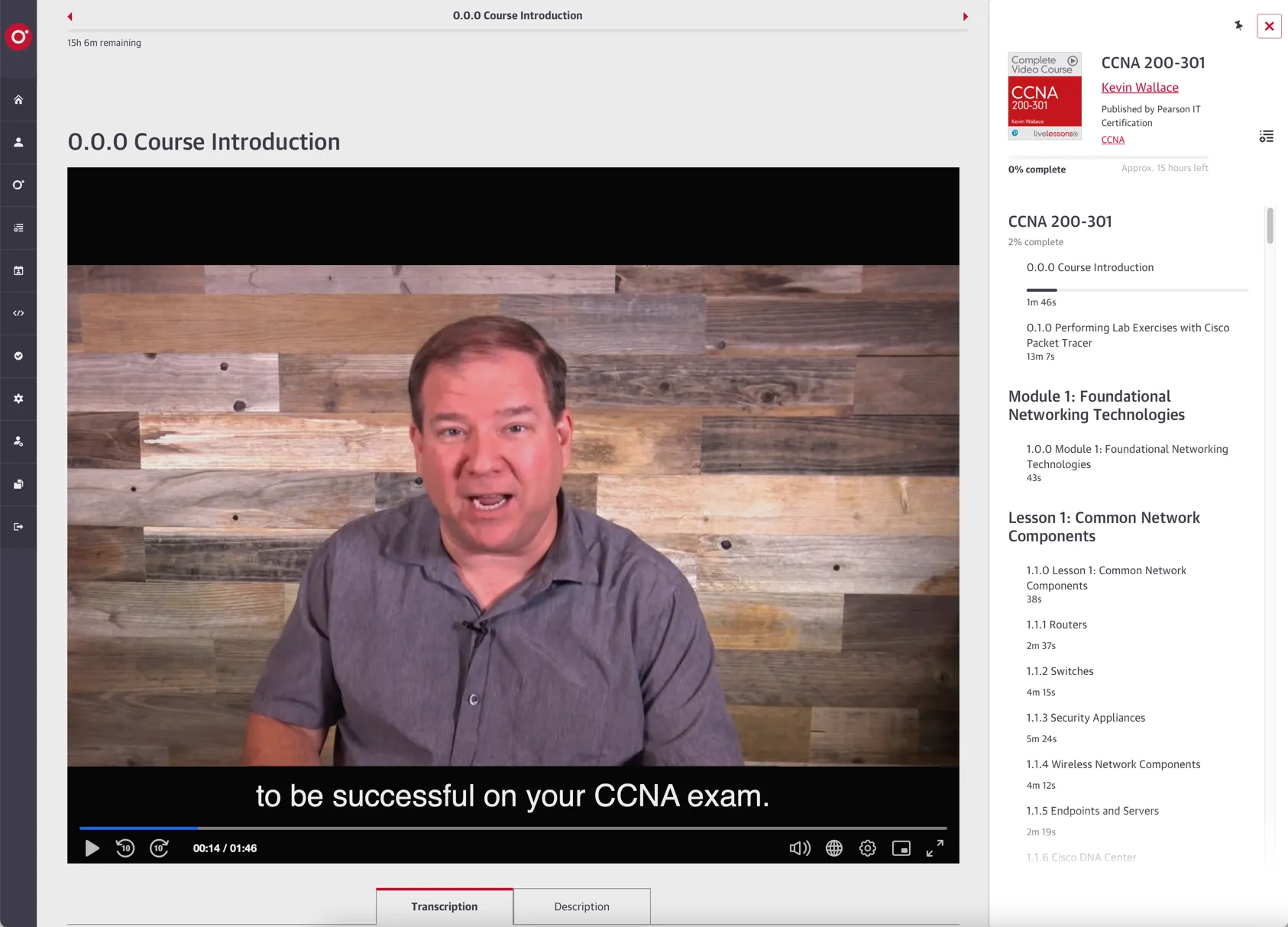
Modules are divided into easy-to-digest lessons and sub-lessons with each lesson ending with an interactive quiz to help you assess your knowledge.
The first nine modules map to the exam objectives and conclude with summaries and module and glossary review quizzes, challenging you to recall information across multiple topics.
Seventeen interactive hands-on exercises are integrated throughout the course, challenging you to apply the knowledge you’ve learned in each lesson.
This new edition also includes the files to perform 9 hands-on labs on the free Cisco PacketTracer software.
This CCNA online course concludes with a series of lessons that give you valuable advice to help prepare for the actual exam.
This CCNA online course also includes two full CCNA practice exams that run in the powerful Pearson Test Prep practice test software. Constructed to help you assess your exam readiness, these practice tests:
- Enable you to focus on individual topic areas or take complete, timed exams
- Include direct references to the Complete Video Course lessons so you can easily reference video content to understand the concepts behind the questions
- Provide unique sets of exam-realistic practice questions
- Track your performance and provide feedback to help you focus your study where it is needed most
CCNA 200-301 Exam Prep LiveLessons
The CCNA 200-301 Exam Prep LiveLessons provides more than 15 hours of online video training detailing common exam traps, pitfalls, and difficulties on the Cisco CCNA exam.
Some of the features include background information on the exams, a deep dive into common mistakes and misunderstandings certification candidates make when taking the exams, and exam walkthroughs with sample questions so you can see firsthand the types of questions you’ll encounter in the testing facility.
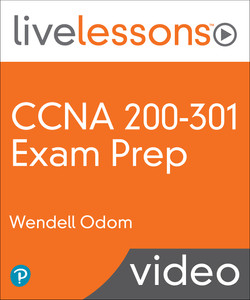
WATCH IT NOW on the O’Reilly Online Learning Platform with a 10-day free trial.
CCNA 200-301 Exam Prep LiveLessons
Author: Wendell Odom, CCIE No. 1624
Published: October 2020
Publisher: Pearson IT Certification
Length: More than 15 hours of instruction
- Module 1: The CCNA Certification and CCNA 200-301 Exam
- Lesson 1: Understanding the Cisco CCNA Certification
- 1.1 Positioning the CCNA Certification
- 1.2 Scheduling and Taking the CCNA 200-301 Exam
- 1.3 Understanding the Credentials of the CCNA Certification
- 1.4 Understanding the CCNA Exam Topics
- Lesson 2: Exam Preparation Tools
- 2.1 Learning with a Comprehensive CCNA Product
- 2.2 Building Hands-on CLI Skills for CCNA
- 2.3 Mastering IPv4 Subnetting Skills
- 2.4 Mastering Late-Stage Learning
- Lesson 3: Exam Strategies
- 3.1 Understanding Cisco Exam Question Types
- 3.2 Strategies Based on Question Type
- 3.3 Strategies Based on Exam Scoring
- 3.4 Strategies Based on the Number of Questions
- 3.5 Strategies for Taking the Exam at a Testing Center
- 3.6 Strategies for Taking the Exam Online from Home/Office
- Lesson 4: Managing Time Pressure on the CCNA Exam
- 4.1 Comparing the Question Counter and Exam Timer
- 4.2 Anticipating Timekeeping Impact of Special Question Types
- 4.3 Choosing an Exam-Day Timekeeping Method
- 4.4 Avoiding Time Pressure
- Lesson 5: How to Best Use this Exam Prep LiveLessons Product
- 5.1 How to Best Use this Exam Prep LiveLessons Product
- Lesson 1: Understanding the Cisco CCNA Certification
- Module 2: Common Mistakes and Misunderstandings
- Lesson 6: Domain 1: Network Fundamentals
- 6.1 Choosing UTP Cable Pinouts
- 6.2 Analyzing Independent Switch Forwarding
- 6.3 Predicting Ethernet Speed and Duplex Mismatches
- 6.4 Using Correct IPv4 Terminology
- 6.5 Finding IPv4 Subnet Facts
- 6.6 Calculating IPv6 Addresses with EUI-64
- 6.7 Abbreviating and Expanding IPv6 Addresses
- 6.8 Designing Ethernet Campus LANs
- Lesson 7: Domain 2: Network Access
- 7.1 Predicting Broadcast Domains
- 7.2 Choosing the Correct VLAN for Frame Forwarding
- 7.3 Predicting STP Convergence Results
- 7.4 Predicting RSTP Convergence Results
- 7.5 Analyzing Topology Using LLDP
- 7.6 The Wireless LAN Controller Distribution Port
- 7.7 Comparing Standalone and Meraki Wireless Architectures
- Lesson 8: Domain 3: IP Connectivity
- 8.1 Applying ARP in Enterprise IP Networks
- 8.2 Predicting Packet Encapsulations Used by IP Routing
- 8.3 Comparing IPv4 and IPv6 Static Route Configuration
- 8.4 Configuring IPv6 Static Routes with Link-Local Next-Hop Addresses
- 8.5 Enabling OSPFv2 on Interfaces
- 8.6 Troubleshooting OSPF Neighbor Issues
- 8.7 Understanding OSPF Neighbor Types
- 8.8 Troubleshooting with Extended Ping
- 8.9 Predicting the Routes Added to a Routing Table
- 8.10 Configuring Routers for VLAN Trunking (Router-on-a-Stick)
- 8.11 Layer 3 Switching with SVIs
- Lesson 9: Domain 4: IP Services
- 9.1 Understanding IP Addresses Used by DHCP Relay
- 9.2 Configuring NAT/PAT with an Interface Address
- 9.3 Viewing Log Messages
- 9.4 Describing QoS Classification and Marking Concepts
- 9.5 Configuring SSH
- Lesson 10: Domain 5: Security Fundamentals
- 10.1 Matching IPv4 Subnets with an ACL
- 10.2 Matching IPv4 Extended ACL Port Numbers
- 10.3 Not Anticipating DoS Attacks Based on DHCP Client Messages
- 10.4 Misunderstanding Core Dynamic ARP Inspection Logic
- Lesson 11: Domain 6: Automation and Programmability
- 11.1 Describing Basic SDN Controller API Concepts
- 11.2 Comparing SDA Overlay and Underlay
- 11.3 Not Anticipating the Need for Data Serialization
- Lesson 6: Domain 1: Network Fundamentals
- Module 3: Exam Walkthrough with Sample Questions
- Lesson 12: Domain 1: Network Fundamentals
- 12.1 Choosing Cable Types
- 12.2 Analyzing Switch Forwarding
- 12.3 Identifying Resident Subnets
- 12.4 Analyzing IPv4 Subnet Masks
- 12.5 Identifying Usable IPv4 Addresses
- 12.6 Analyzing Existing Subnets
- 12.7 Finding an IPv4 Resident Subnet
- 12.8 Analyzing IPv4 Addresses
- 12.9 Assigning IPv6 Addresses
- 12.10 Identifying IPv6 Addresses Used by Routers
- 12.11 Verifying IPv6 Addresses on Router Interfaces
- 12.12 Predicting IPv6 Addresses That Use EUI-64
- 12.13 Predicting MAC Table Entries
- 12.14 Predicting Learned IPv6 Routes
- Lesson 13: Domain 2: Network Access
- 13.1 Refreshing MAC Addresses
- 13.2 Configuring Access VLANs
- 13.3 Verifying VLAN Trunks
- 13.4 Verifying Voice and Data VLANs
- 13.5 Predicting Encapsulation on a Phone Pseudo Trunk
- 13.6 Predicting STP Topology and Convergence Results
- 13.7 Configuring Layer 2 EtherChannel
- 13.8 Configuring Layer 3 EtherChannel
- 13.9 Analyzing Wireless LAN Basics
- 13.10 Wireless LAN Split MAC Operation
- Lesson 14: Domain 3: IP Connectivity
- 14.1 PC A Cannot Ping PC B
- 14.2 End-to-End Data Plane Forwarding
- 14.3 Troubleshooting Switch and Router Trunking
- 14.4 Configuring Router-on-a-Stick
- 14.5 Troubleshooting OSPFv2: #1
- 14.6 Verifying OSPFv2
- 14.7 Compare and Contrast Distance Vector and Link State Protocols
- 14.8 Troubleshooting OSPFv2: #2
- 14.9 Interpreting show ip route
- 14.10 Determining Types of IPv6 Static Routes
- Lesson 15: Domain 4: IP Services
- 15.1 Configuring NTP Client/Server
- 15.2 Identifying QoS Functions
- 15.3 Predicting Log Message Distribution
- 15.4 Configuring Switch Management Address
- Lesson 16: Domain 5: Security Fundamentals
- 16.1 Matching Subnets with ACLs
- 16.2 Matching Transport Layer Ports with ACLs
- 16.3 Protecting the CLI with IPv4 ACLs
- 16.4 Configuring Different Enable Passwords
- 16.5 Describing RADIUS Basics
- 16.6 Troubleshooting Port Security
- 16.7 Configuring DAI
- 16.8 Protecting DHCP
- Lesson 17: Domain 6: Automation and Programmability
- 17.1 Using Data Plane Terms
- 17.2 Describing the Functions of a Controller
- 17.3 Comparing Configuration Management Tools
- 17.4 Comparing JSON, XML, and YAML
- Lesson 12: Domain 1: Network Fundamentals
- Summary
In Module 1, best-selling author and expert instructor Wendell Odom explores essential information about the Cisco CCNA certification, such as what to do if you get stuck on a question, what to expect in the testing facility, and how to manage your time.
Module 2 is dedicated to helping you preemptively learn about common misunderstandings people make about the exams in all six exam domains: network fundamentals, network access, IP connectivity, IP services, security fundamentals, and automation and programmability. This section also focuses on commonplace mistakes that people make.
Module 3 takes you on a deep dive into the types of questions you’ll encounter for each domain in the exam. In this section, you will have the opportunity to assess sample questions and see firsthand how the author solves each one while detailing why the right answer is correct and how to avoid pitfalls. This course is meant to help you prepare for your exam and identify areas of weakness while improving your conceptual knowledge and hands-on skills.
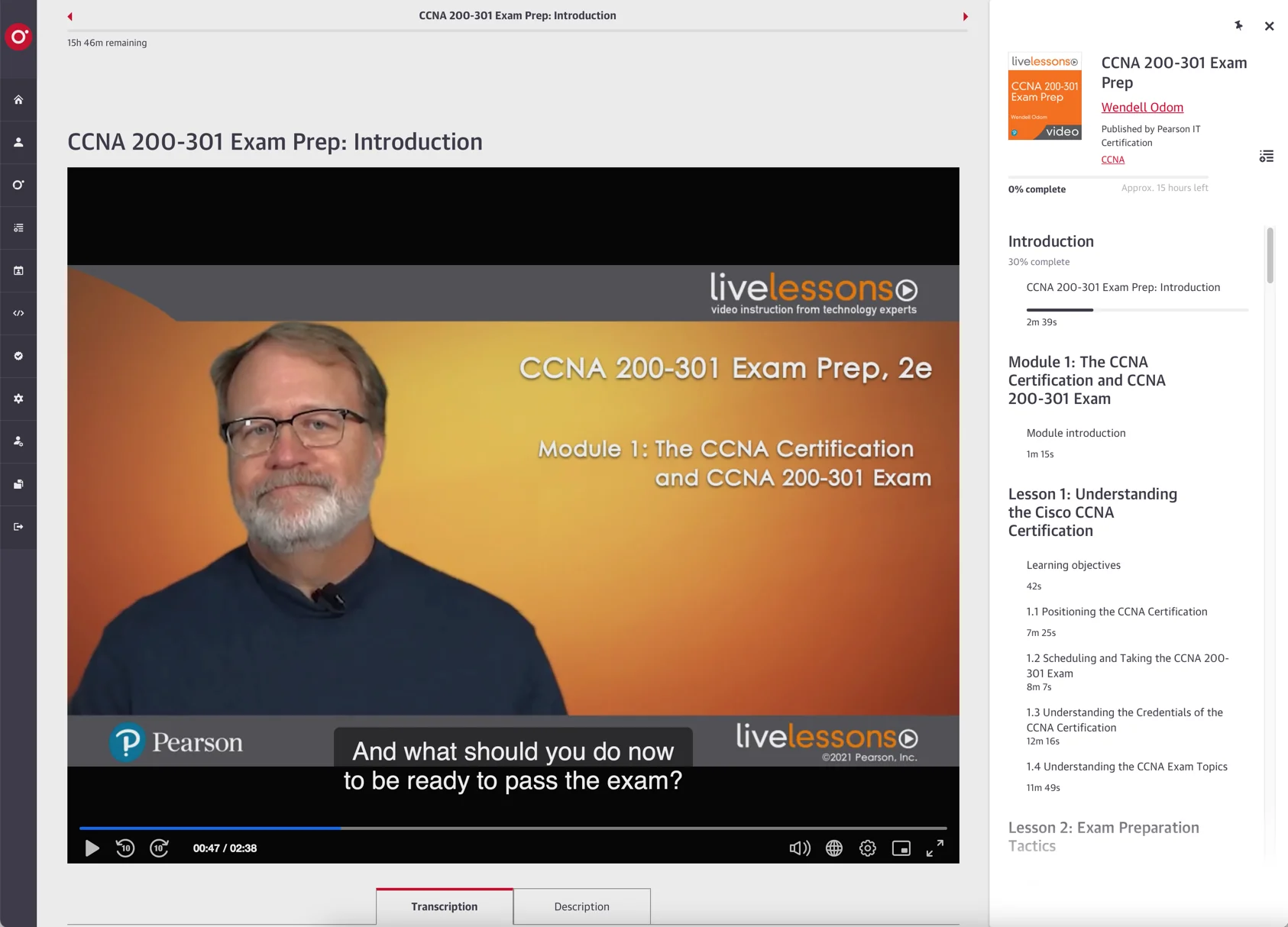
IMPORTANT: The CCNA 200-301 Exam Prep LiveLessons video course is a secondary resource for the Cisco CCNA 200-301 exam and assumes that the user has already studied the basics of each CCNA exam topic. This CCNA course is designed to help you troubleshoot where you might go wrong on the exam and to clarify common misunderstandings. It does not cover every objective on the exam and should not be used as a sole study resource. For full coverage of the exam, please reference the CCNA 200-301 Complete Video Course.
CCNA 200-301 with Ben Jacobson
This CCNA 200-301 training course will also help you build a solid foundation in networking concepts.

WATCH IT NOW on the O’Reilly Online Learning Platform with a 10-day free trial.
CCNA 200-301 with Ben Jacobson
Author: Ben Jacobson
Published: December 2020
Publisher: Packt Publishing
Length: 18 hours and 40 minutes
- Laboratory Environment
- Course Overview
- Introduction
- Introduction to Graphical Network Simulator-3 (GNS3)
- Setting up Graphical Network Simulator-3 (GNS3)
- Working with Physical Devices
- Network Fundamentals
- Network Terminology
- Routers, Switches, and Firewalls
- Access Points (APs), Controllers, and Endpoints
- Network Topologies
- Physical Cabling
- Layer 1 Troubleshooting
- Layer 2 Concepts
- Layer 3 – Internet Protocol version 4 (IPv4) Concepts and Configuration
- Layer 3 – IPv6 Addresses and Configuration
- Layer 4- Comparing Transmission Control Protocol (TCP) and User Datagram Protocol (UDP)
- Wireless Principles
- Virtualization Fundamentals
- Network Access
- Virtual Local Area Network (VLAN) Fundamentals and Configuration
- Dot1q Fundamentals and Configuration
- Layer 2 Discovery Protocols
- Rapid per VLAN Spanning Tree (RPVST) – Part 1
- Rapid per VLAN Spanning Tree (RPVST) – Part 2
- EtherChannels Concepts and Configuration
- Wireless Architectures and Access Point (AP) Modes
- Physical Wireless Local Area Network (WLAN) Connection and Management
- Configuring a Wireless Local Area Network (WLAN) in a Wireless LAN Controller (WLC)
- IP Connectivity
- Reading a Routing Table
- Routing Decisions and Route Attributes
- Internet Protocol version 4 (IPv4) and Internet Protocol version 6 (IPv6) Static Routing
- Open Shortest Path First version 2(OSPFv2) – Part 1
- OSPFv2 – Part 2
- First Hop Redundancy Protocol (FHRP)
- IP Services
- Configuring the Source Network Address Translation (NAT)
- Configuring Network Time Protocol (NTP)
- Dynamic Host Configuration Protocol (DHCP) and Doman Name System (DNS) Fundamentals
- Configuring DHCP
- Simple Network Management Protocol (SNMP) and Syslogging
- Quality of Service (QoS)
- Secure Shell (SSH)
- File Transfer Protocol (FTP) and Trivial File Transfer Protocol (TFTP)
- Security Fundamentals
- Defining Key Security Concepts
- Elements of a Security Program
- Authentication, Authorization, and Accounting (AAA)
- Site-to-Site (S2S) and Remote Access (RA) Virtual Private Network (VPN)
- Access Control Lists (ACLs)
- Layer 2 Security
- Wireless Security
- Automation and Programmability
- Automating Network Management
- Controller-based and Software Defined Networking (SDN) Architectures
- REST Application Program Interface (APIs)
- Configuration Management Systems
This CCNA course walks you through the following:
- An introduction to Graphical Network Simulator-3 (GNS3) and the step-by-step process to set up the environment.
- Network terminologies, such as a router, switches, firewalls, topologies, and virtualization fundamentals.
- The fundamentals of Virtual Local Area Network (VLAN) and Wireless Local Area Network (WLAN), wireless architectures, and access point modes.
- IP connectivity, IP services, and security fundamentals.
- Automation of network management, the configuration of management systems, and study of Software Designed Networking (SDN) architectures.
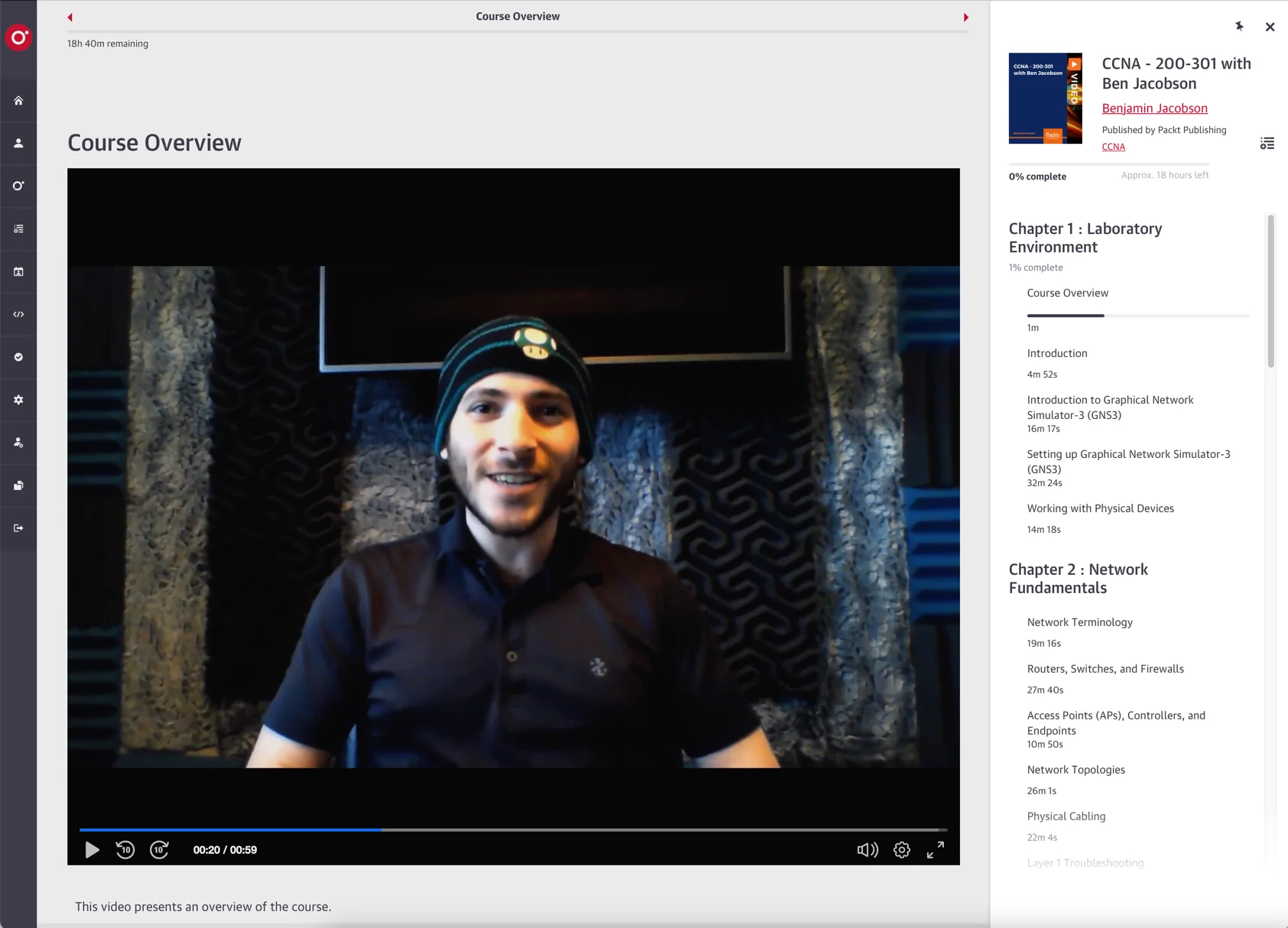
By the end of this course, you will have developed the skills and confidence to pass the new 200-301 CCNA exam.
Wrapping Up
In preparation for your CCNA certification, I personally recommend learning networking technologies with a combination of videos, books, and labs. You first learn how networking technologies work and understand what problems they’re designed to solve, and then you do labs.
Start with Kevin Wallace’s CCNA 200-301 Complete Video Course and then jump to Wendell Odom’s CCNA 200-301 Exam Prep LiveLessons. You also have Ben Jacobson’s CCNA 200-301 course to complement.
If there are concepts that aren’t clear, consult with CCNA Books from different authors to find different explanations from different sources. In the networking field, CCNA foundation concepts are very important as the first set of building blocks for your professional career.
I hope this post was informative to you, and good luck in your CCNA journey.
Let me know if you have any questions in the comments section below.
